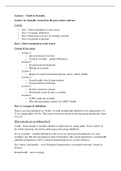Class notes
Lectures Youth And Sexuality ()
- Course
- Institution
Complete notes of all lectures in the youth and sexuality course (for both exams). NOTE: these are notes made in 2021/2022, I cannot guarantee that the lectures will be exactly the same in later years.
[Show more]




